ART: This course, which is based on discussion rather than lecture, is still somewhat experimental; it may take a couple of weeks (and a few polls) before I know how best to handle it. The first hour of each class, though, will consist of a number of comparisons like the one below, which I offer as an advance sample. This image, and all other similar ones with a star in the bottom corner, can be clicked on to show each of the pictures at larger size. The questions underneath it are samples of the ones I may ask in class. Think about them now, to get the ball rolling. rb.
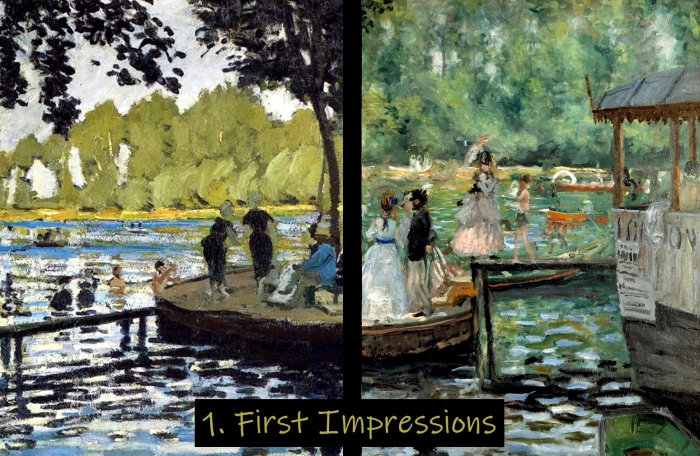


Some questions: So much is the same, but what are the differences between the two paintings? Which is the more zoomed in? Which has the more details? The larger brushstrokes? The wider range of color? How do they differ in their treatment of water? Which artist is more interested in the people? And what is the prime interest of the other?
MUSIC: The second hour of each class will focus on some other art. Often this will be music, and in
the first class I want to focus on Claude Debussy. I am trying the experiment of showing musical examples along with the scores.
Although I know that many (most?) people do not read music, the turning of the pages (which I will number on the videos shown in
class) at least provides landmarks from which to anchor your impressions.
We will attempt two comparisons involving two short piano pieces that I will play at the time, just asking your immediate
reactions. But you might warm up by thinking about this one, a slightly longer piece called The Sunken Cathedral.
Unlike most of the other pieces in the first book of Preludes from which it comes, it has a story of sorts. Debussy called
on an "ancient Breton myth in which a cathedral, submerged underwater off the coast of the Island of Ys, rises up from the sea on
clear mornings when the water is transparent. Sounds can be heard of priests chanting, bells chiming, and the organ playing, from
across the sea" [Wikipedia]. So listen to it at the link below, take notes, and see if you can match the scenario to changes in
the musical texture. We will play it again in class, and discuss.
Debussy: The Sunken Cathedral, played by Nelson Friere.
PEOPLE: Here are brief bios of the artists we shall consider in the class, plus the one composer,
listed in chronological order of birth. You can access all biographies via the BIOS link on the
syllabus page.
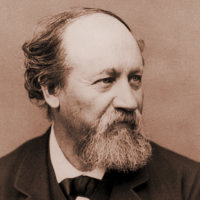 |
Eugène Boudin, 1824–98. French painter. The son of a sailor, Boudin spent most of his life in and around Le Havre, painting beach and harbor scenes notable for their pearly tone and luminous skies. Many of these were painted out of doors, and he was he who introduced fellow Le Havre native Claude Monet to this practice, which would be a central tenet of Impressionism. |
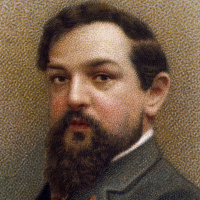 |
Claude Debussy, 1862–1918. French composer. Debussy was one of the most original French composers of the 20th century and, with Ravel, the prime exponent of what is commonly called Impressionism, the creation of musical images through harmony, texture, and scraps of melody. Although an exquisite orchestrator, his most original works are probably those written originally for piano, including two books of Preludes from the last years of his life. |
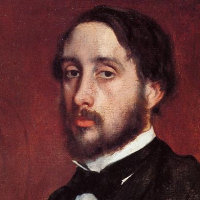 |
Edgar Degas, 1834–1917. French painter and sculptor. The son of a wealthy banker, he originally trained for the law. When he did go into art, he painted mostly traditional subjects until Manet introduced him to the Impressionists, at which point he turned entirely to scenes from everyday life. Although he was the only artist to participate in all eight Impressionist shows, he strongly resisted the term, and pursued his own quite original course. |
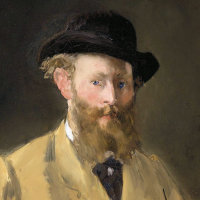 |
Édouard Manet, 1832–83. French painter. Manet is arguably the greatest French painter in the third quarter of the 19th century. Though primarily a realist, he was influenced by older artists such as Titian and Velasquez. He was admired by the young Impressionists, became friends with Monet, and produced a number of works in their style, but he never exhibited with them, preferring to retain his own status in the official Salons. |
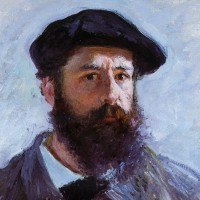 |
Claude Monet, 1840–1926. French Impressionist painter. The central figure in Impressionism (it was his Impression: Sunrise of 1872 that gave the movement its name), he intensified its focus more than any other artist, continuing well into the next century to produce series of paintings showing minute variations in the light and color in basically the same scene. Cézanne famously said of him, "Monet is nothing but an eye—but my God, what an eye!" |
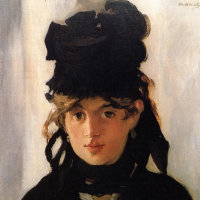 |
Berthe Morisot, 1841–95. French painter. A descendant of Fragonard, pupil of Corot, sister-in-law of Manet, and later member of the Impressionist group, she brought a fine sensibility to her mainly domestic subjects painted in her characteristic limpid style. Some of her landscapes, however, could be as strong as any of her male colleagues. |
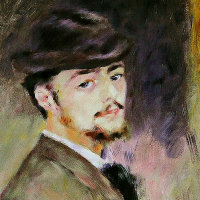 |
Pierre-Auguste Renoir, 1841–1919. French painter. A leading member of the Impressionist group, he began his career as a china painter in the Limoges factory, which—together with his admiration of Rococo masters such as Watteau and Fragonard—may have influenced the sweetness of color seen in much of his work. He was more concerned with detail, and more interested in figures than most of his colleagues. |
ART: For the paintings discussed (or intended to be discussed) in class see below. Scroll to the end or click these links to reach the sections on MUSIC and BOOKS.
COMPARISON 1



Some questions: So much is the same, but what are the differences between the two paintings? Which is the more zoomed in? Which has the more details? The larger brushstrokes? The wider range of color? How do they differ in their treatment of water? Which artist is more interested in the people? And what is the prime interest of the other?
Some facts: La Grenouillère (the frog pond) was a restaurant on the banks of the Seine that also provided bathing facilities and boat hire. Although Monet and Renoir could not afford to eat there, they could at least paint side-by-side on the bank. Monet felt that pictures of the middle-classes at leisure might have a chance of selling.
COMPARISON 2



Some questions: Looking at the Boudin alone for the moment how would you describe the brushwork? The range of colors? The reality of the buildings in the background—could you make a model of them? Is there a specific time of day? Now ask the same questions of the Monet; the answers may be different. And an off-the-wall question: if you could own either picture in a good reproduction, which would you choose and why?
Some facts: Monet studied briefly with Boudin, who impressed upon him the importance of painting in the moment. When asked to title his painting at the 1874 Impressionist exhibition (the first), Monet tossed out Impression: Sunrise, because he did not want to claim that he was objectively delineating Le Havre. The title was siezed on by a carping critic, and in turn was adopted by the artists themselves.
COMPARISON 3



Some questions: The Manet contains figures; is it a portrait? And if not, why not? The Monet painting is obviously the background of the Manet, without the railings: which picture has the greatest sense of depth? What can you say about the composition of each? Take the terms "lens" and "frame": how would they apply? What is the darkest color in each, and the lightest? How does each artist treat the steam? Why do you think each painter chose to do his picture there?
Some facts: Manet's sitter was Victorine Meurent, who was also the model for his Luncheon on the Grass and Olympia. She was also a painter. One of the buildings visible behind the railway cutting is the apartment block where Manet was living at the time. While this setting was unique in Manet's work, Monet made about a dozen paintings of the station.

Monet: Gare Saint Lazare (1877, Orsay)
Some questions: How many colors are in the painting? Take any small area of it, and count the colors there; are there any that surprise you? What was Monet's subject in the painting? How realistic is it?
Some facts: Renoir tells a story about Monet going to the Director of the Station and introducing himself as "The painter Monet." Thinking that he was dealing with a famous man, the Director supposedly stopped the trains and got the engines to belch out copious steam, finally escorting artist out with respectful bows. The story does not entirely hold true, however, because it does not allow for the numerous different paintings that Monet made of the subject, all clearly observed in situ.
COMPARISON 4



Some questions: Which picture has the more depth? What is the dominant hue in each? Are there any differences in the brushwork? What is the source of the light? What can you say about the hats? What is the class of the people in each picture? What kind of music is playing? Do any individuals stand out from the crowd, and how has the artist made this happen? Might any of them be portraits of real people? Is there any influence of photography in either painting? Are both painted on the spot?
Some facts: Chek the Wikipedia articles for information about the real people in each painting. Those in the Manet include some famous figure such as Offenbach, Baudelaire, and Théophile Gautier. Renoir's are personal friends and less well-known; apparently, he provided fashionable hats as an inducement—but surely also to give his painting a rhythm?
COMPARISON 5



Some questions: What is the color-chord in each picture? What differences are there in handling (brushwork)? Which painting is more like a photograph? What sense do you get of what lies beyond the frame? Who are the people in each picture? If the Degas is a portrait, is it only a portrait? Why did he choose this setting?
Some facts: The man with the cane and straw hat seen twice in the Renoir picture is his brother Edmond, who would delay passers-by for long enough for the artist to record their appearance. The man in the front of the Degas picture is the businessman Ludovic Lepic, with his dog and two daughters. Degas also painted them in a more conventional portrait.
COMPARISON 6



Some questions: How would you describe the composition and framing of each picture, the woman's relationship to the whole? How does the color-chord affect your view of the subject? Who are the women, and what does the picture tell you about their lives? What is each thinking or feeling, and is this relevant? What do you think might be the immediate past and future in each case?
Some facts: The model for both the Degas and Manet pictures is the same woman, the actress Ellen Andrée. Morisot painted her sister Edma, with her niece Blanche. The yellowish drink in front of the woman in the Degas is absinthe, notoriously addictive and hallucinogenic, and since banned. When it was first shown, critics panned the picture as disgusting and immoral, or at best an object-lesson.

Degas: Dance Class (1873, Corcoran)
Some questions: What is the medium here, oils or pastel? What are the main colors? And against this, how does Degas use the accents? How many dancers are there (and is this significant)? Can you divide them up into groups, and say what each is doing? Would you call the picture casual, or ordered? Or perhaps both? [PS. If this is a dance class, then where's the teacher?]
Some facts: Beginning in 1868, Degas constantly returned to the theme of ballet dancers. Mostly, he treated the subject as part of his general interest in women at work; cf. his series of Milliners. But he also painted them because they sold and the combination of costumes and artificial stage lighting made for subtle and arresting combinations of colors.
MUSIC: Check the links below to hear the various Debussy pieces played in the second hour of the class; all clips include the score, though without any annotations I may have added to the versions shown in class:
La cathédrale engloutie
Bruyères
Les collines d'Anacapri
The Golliwog's Cakewalk
Minstrels
General Lavine, Eccentric
The script for this part of the class can be found here.
BOOKS: Where relevant, I will try to suggest books that expand on some of the ideas or artists discussed in class. With Impressionism, this is difficult, because there is so little between academic tomes and mere picture books of varying quality, but I would suggest the first two books below to bridge the gap. The book on Debussy is new, so I haven't seen it, but it looks ideal for the kind of things we do. rb.
WOLF, Norbert: Impressionism: Reimagining Art (Prestel, 2015)
GRIMME, Karin H.: Impressionism (Taschen, 2017)
KAUTSKY, Catherine. Debussy's Paris: Piano Portraits of the Belle Époque (2019)
PEOPLE: Here are brief bios of the artists considered in the class, in order of birth.
You can access all biographies via the BIOS link on the syllabus page.
 |
Eugène Boudin, 1824–98. French painter. The son of a sailor, Boudin spent most of his life in and around Le Havre, painting beach and harbor scenes notable for their pearly tone and luminous skies. Many of these were painted out of doors, and he was he who introduced fellow Le Havre native Claude Monet to this practice, which would be a central tenet of Impressionism. |
 |
Claude Debussy, 1862–1918. French composer. Debussy was one of the most original French composers of the 20th century and, with Ravel, the prime exponent of what is commonly called Impressionism, the creation of musical images through harmony, texture, and scraps of melody. Although an exquisite orchestrator, his most original works are probably those written originally for piano, including two books of Preludes from the last years of his life. |
 |
Edgar Degas, 1834–1917. French painter and sculptor. The son of a wealthy banker, he originally trained for the law. When he did go into art, he painted mostly traditional subjects until Manet introduced him to the Impressionists, at which point he turned entirely to scenes from everyday life. Although he was the only artist to participate in all eight Impressionist shows, he strongly resisted the term, and pursued his own quite original course. |
 |
Édouard Manet, 1832–83. French painter. Manet is arguably the greatest French painter in the third quarter of the 19th century. Though primarily a realist, he was influenced by older artists such as Titian and Velasquez. He was admired by the young Impressionists, became friends with Monet, and produced a number of works in their style, but he never exhibited with them, preferring to retain his own status in the official Salons. |
 |
Claude Monet, 1840–1926. French Impressionist painter. The central figure in Impressionism (it was his Impression: Sunrise of 1872 that gave the movement its name), he intensified its focus more than any other artist, continuing well into the next century to produce series of paintings showing minute variations in the light and color in basically the same scene. Cézanne famously said of him, "Monet is nothing but an eye—but my God, what an eye!" |
 |
Berthe Morisot, 1841–95. French painter. A descendant of Fragonard, pupil of Corot, sister-in-law of Manet, and later member of the Impressionist group, she brought a fine sensibility to her mainly domestic subjects painted in her characteristic limpid style. Some of her landscapes, however, could be as strong as any of her male colleagues. |
 |
Pierre-Auguste Renoir, 1841–1919. French painter. A leading member of the Impressionist group, he began his career as a china painter in the Limoges factory, which—together with his admiration of Rococo masters such as Watteau and Fragonard—may have influenced the sweetness of color seen in much of his work. He was more concerned with detail, and more interested in figures than most of his colleagues. |
